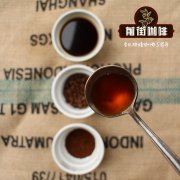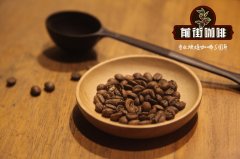The new breed of coffee resistant to leaf rust in Manor Manor got a high score of 90 in Nicaragua's Excellence Cup Competition.

The new coffee variety, called Centroamericano, is a F1 mating variety that scored 90 points in the Excellence Cup and was awarded the highest honor of the Presidential Award.
This coffee won the second place in the Excellence Cup and came from Mr. Moreno's Bull Manor.
Bull Manor is located in the northern province of New Serbia in Nicaragua, near the border with Honduras. The jury came from nine countries with a cup score of 90.5. The coffee flavor was rated as rich and fruity with cinnamon, peaches, cherries, wild berries, drupes, cocoa, hazelnuts, pineapples and limes. And was awarded the highest honor award for coffee, the Presidential Award, which is usually awarded only to beans with a high score of 90-100 points.
Nearly a thousand coffee beans take part in the Outstanding Cup competition every year, and the award-winning coffee can be promoted around the world through online auctions. Mr. Moreno will auction his 24 cases of 30KG award-winning coffee at 6 amp 1.
This year is the second time that the Central American species has participated in the Excellence Cup and won the prize. Because it is a brand new variety, it has only begun to be commercialized and promoted to more owners, but only in Central America. At the beginning of F1 research and development, cup tests were carried out in the estates of Nicaragua, so Nicaragua has more advantages to produce coffee beans of F1 mating varieties.
Mr. Moreno's coffee has attracted special attention because it is resistant to leaf rust in addition to winning high scores in the excellent cup competition. Leaf rust became prevalent in 2012, resulting in a significant reduction in coffee production during severe periods. This variety is resistant to leaf rust, so it is estimated that the yield of this variety can increase by 22-47% more than the standard yield. The government released the variety to coffee farmers in Central America in 2010 and now has an area of about 1000 hectares. This variety was mated by Ethiopia native variety RUME SUDAN and leaf rust resistant variety T5296. Including CIRAD, a French research institution, PROME CAF É, a Sino-American coffee research institution, and CATIE, a coffee genetics bank in Costa Rica.
This mating species has high quality, can resist leaf rust, increase yield and reduce the risk of coffee farmers. Although the agricultural performance of this variety has been affirmed in many fields, its potential has not been verified by the Outstanding Cup. The success of the Cen Central American species stems from its being one of the FI mating varieties. This new variety uses Arabica genes and F1 offspring. The most famous example of F1 hybrid is corn. Since the corn was mixed, the yield of corn in the United States has increased six times over the past 60 years. Over the past decade, including tomatoes and cauliflower have also used F1 mating experience to increase yield. This is the first time this mating has been used in coffee.
The World Coffee Research Institute believes that F1 mating varieties have been genetically modified to bring great hope to the coffee industry. Just as F1 mating varieties of corn are being planted in Central America and Africa. Forty-six new F1 mating varieties are also being tested at the World Coffee Research Institute's experimental farm in El Salvador.
Given that only a small number of coffee farmers really know what they are growing, coffee research institutions have determined that 90% of the coffee is indeed Central American, optimistically predicting that this will be a potential variety and an important milestone.
The CEO of the World Coffee Research Institute said he was very happy with the results and was more certain that FI mating varieties were indispensable in the future. This variety can also fight the disease of coffee trees by providing yield. It was difficult to strike a balance between them in the past, but there is an opportunity to take a big step forward in the future.
The Coffee Excellence Alliance said the cup test results of 90 points confirmed the potential for high quality of F1 mating varieties. In the future, we will continue to work with world research institutions to collect and hold competitions related to coffee varieties. At the same time, establish a high standard of integrity and transparent certification program to ensure the correctness of genes and the health of coffee trees.
Important Notice :
前街咖啡 FrontStreet Coffee has moved to new addredd:
FrontStreet Coffee Address: 315,Donghua East Road,GuangZhou
Tel:020 38364473
- Prev

Coffee treatment | what is the difference between carbon dioxide impregnation and anaerobic fermentation?
Without an in-depth study of biochemistry, we can assume that all coffee (with different treatments) has undergone a certain degree of fermentation. Fully washed coffee must go through an artificial fermentation stage, in which the coffee seeds are fermented after the peel and pulp are removed (sometimes the coffee seeds are placed in water, sometimes no water is used in the fermentation process) and then
- Next

Comparison among solarization, water washing and honey treatment what is the effect of peeling on flavor
The advent of honey processing began in the 1990s with the advent of pulped natural in South America and Brazil, a processing revolution aimed at a compromise between washing and tanning. In the end, how does honey treatment differ from traditional sun exposure or water washing? The following words are all related to honey treatment, and we can understand the differences from these words to describe honey treatment: pseudo-natur
Related
- Beginners will see the "Coffee pull flower" guide!
- What is the difference between ice blog purified milk and ordinary milk coffee?
- Why is the Philippines the largest producer of crops in Liberia?
- For coffee extraction, should the fine powder be retained?
- How does extracted espresso fill pressed powder? How much strength does it take to press the powder?
- How to make jasmine cold extract coffee? Is the jasmine + latte good?
- Will this little toy really make the coffee taste better? How does Lily Drip affect coffee extraction?
- Will the action of slapping the filter cup also affect coffee extraction?
- What's the difference between powder-to-water ratio and powder-to-liquid ratio?
- What is the Ethiopian local species? What does it have to do with Heirloom native species?

